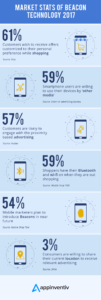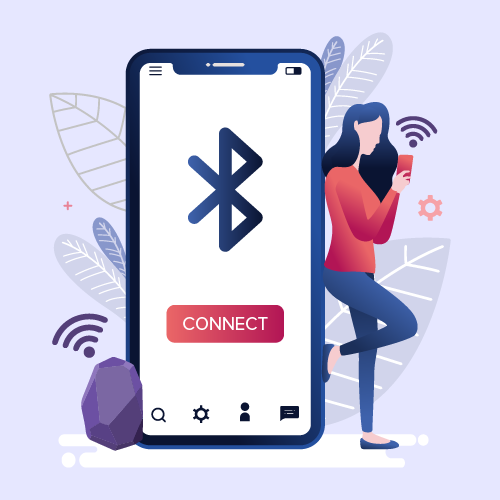All There’s to Know About Beacon Technology for Mobile Apps
Beacons have become one of the most profitable investments that an industry can make to seamlessly blend offline world with online.
By sitting silently on the corner of a wall, Beacons can effortlessly solve your issues from declining footfall in your store to hiring an additional resource to just show the students around.
So, what exactly is the technology that holds all the immense powers? And how does it work? And how can you use it irrespective of what industry you belong to?
We will answer all these questions and then some more.
Hold on to whatever device you are on and let’s begin…
But before that, let’s look at the technology’s market share

What is Beacon Technology?
In the most simplest sense, Beacon is the technology that alerts websites or apps when someone has entered or left the location they are placed in. In other terms, retail (one of the major users of Beacon) have beacons attached on their venue which detects where a customer is at any given point of time in or around their store.
Now that you know what the technology is, let us now see the different type of Beacon Protocols in the market.
Type of Beacons Protocols
1. iBeacon – by Apple
2. Eddystone – by Google
3. AltBeacon – by Radius Networks
4. GeoBeacon – by Techno-World
5. Nearby – by Google
How does Beacon Technology works?
Suppose you enter a mall and cross the Mac store. Now the instant you cross the store, you get a message on your phone informing you of a discount in the outlet. Seeing the discount, you enter the store and as you are moving from one window to another, you now start getting product specific discount notifications on your smartphone Beacon app.
The above scenario is the doing of Beacon technology.
Now’s let dive in a little in the exact functioning of the technology –
![]()
Technically, every hardware device which supports Bluetooth 4.0 can act as a beacon. Meaning PCs, smartphones, and tablets can work as beacons.
The beacon constantly scans for the mobile devices which have an open Bluetooth and are added with the associated mobile app. As soon as the beacon detects a device that fulfills the conditions, it sends them a connection request to make the app active.
Once done, it sends real time information to the users on their app.
So the functioning elements here are –
– Beacon Device in the store
– App that supports the Beacon technology
– Open Bluetooth
While Retail is one of the most advertised industry to be using the technology, there are other industries that have been making use of the Beacon technology to offer better services to their users.
Let us look at some of the industries’ usage of the location based technology.
Use cases of Beacon Technology
1. Retail
– Send offers and discounts to a customer when he/she is near a product or a certain shelf
– Admins could get relevant data about slow days and full days to optimize their workflow and service accordingly
– Offer stickers and collectable items that they can only receive if they visit certain parts of the store or attend certain events or sales
– Provide detailed maps of a mall with all the facilities and parking information with the voice navigation
– Users could get a higher discount if they invite and bring new customers and etc.
2. Healthcare
– Drug stores can promote free check-ups to bypassers
– Hospitals can offer detailed maps with elevators, guides, detect your current position
– Hospitals can offer a view map with all facilities as icons on the map and visitors will be able to search by department/facility title/specialist, create a route to a needed object/facility, navigate to object/facility
– Hospitals can offer a map so that visitors will find their cars on parking area
– Hospitals can promote any event taking place
3. Real Estate
– Notify prospective client when they drive by a house up on the market
– Give property information in open houses
– With beacons, real estate agents will gain insights in buyer’s offline property buying experience. They will know when their prospects viewed the house’s information and if it after leaving the open house
4. Education
– Guided campus tours to new students
– Beacons in bookstore can give information to students of the cost or discount on an book
– In library, students can see the waiting line without having to come near the counter
– Taking attendance becomes a thing of the past with the real time reading of students’ presence in the classroom
– By notifying the administration of the student’s location, student safety on the campus reaches an elevated level
5. Travel
– Expedite security check in airports and subways
– Room availability information upon crossing a chain of hotels
– Keyless entry in hotel rooms
– Notification on the events happening around a location
– Offers and discounts in restaurant and clubs
Beacons have found a place in a number of industries, globally. The advancement and benefits it offers, has created a great demand in the mobile app industry. But, for a technology that is so precise and real time, there are a number of challenges that app development agencies face while incorporating it in their apps.
Here are the challenges that we faced when we developed Beacon apps and how we solved them. Read this part as a miniature case study of two of the most well adopted Beacon apps of all times.
Our experience with Beacon Apps
We get request for Beacon app development frequently from customers who are looking to tap a greater market in real time and make the most of the connection between their online and offline store.
We recently made two apps – Glubbr and Parking Caddie, both working on proximity based technology.
The idea behind them –
Glubbr was a restaurant based app. The idea was that a device would be converted in a Beacon which the customers would be join to chat and get offers.
Parking Caddie was an app that gave people information on the open parking space in their area.
The challenges we faced and the solution we incorporated
With Glubbr, the challenge was to inform people of the app and educate them to use it. Here the challenge was completely on the marketing front. After a proper promotion plan, we were able to educate the restaurant customers of the technology and could convince them to use the app.
Parking Caddie came with its own set of issues with the most prominent one being floor mapping of all the parking spaces. To solve this, we integrated the app with the Estimote SDK. With the SDK, it became easier to not just map but also cover the fleet management part effortlessly.
While these were the challenges that we faced, usually educating people to use the app and keep their Bluetooth on when near a beacon is the most crucial part. Next comes floor mapping, while we had to work around an open space, it pose a challenge when using beacons in a mall or airport where there are multiple entry ways, stairs, escalators etc.
But the growing demand of the technology has brought with itself a set of solutions for the problem too. So, in the end it’s all workable, until you are avoiding the Beacon app development mistakes.
Beacons are changing how establishments interact with its customers as we talk. The technology is penetrating the world around us at a much faster rate. Are you up for it?

strategies your digital product..



